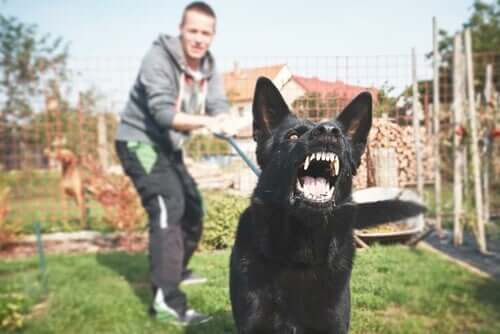How to Train a Potentially Dangerous Dog

Some say that any dog, regardless of its breed or size, can be potentially aggressive and dangerous. However, many veterinarians and pet and animal advocates vehemently reject the term potentially dangerous dog. In this article, we focus on explaining how to train a potentially dangerous dog.
Although many studies claim that Chihuahuas are more aggressive than Pitbulls, a Pitbull bite is more serious than that of a Chihuahua.
The problem in most cases isn’t the dog per se nor their supposed propensity for violence. The key to dangerous dogs or dogs that are aggressive or have general behavioral problems is usually the human owner who’s responsible for training them.
Any poorly trained dog or a dog trained with violence is a potentially dangerous dog.
Legislation on dangerous or violent dogs

No matter whether you agree with the use of the term potentially dangerous dog or not, the truth is that some breeds run the risk of becoming deadly if they aren’t well trained.
Most countries regulate the ownership of these animals in an attempt to minimize possible risks.
Breeds with the greatest risk
Here are some of the breeds that are usually categorized as potentially dangerous:
- American Pit Bull Terrier
- Staffordshire Bull Terrier
- American Staffordshire Terrier-Amstaff
- Rottweiler
- Dogo Argentino
- Fila Brasileiro
- Tosa
- Akita
Likewise, citizens who wish to adopt any of these breeds must usually meet certain requirements. For example, they must be of age, have no criminal record, and have proven physical and psychological capacity.
Things to bear in mind
The animals that may cause more harm are those with a girth measurement of 23 to 31 inches. Also, those with a height of 19 to 27 inches, a voluminous and robust head, as well as a wide and large skull, muscular cheeks, and bulging, giant, and strong jaw, wide mouth, and those that weigh more than 44 pounds.
The first months largely define a dog’s personality. Puppies should remain under their mother’s care during the first two months of their lives. During this crucial time, they learn everything about canine language, as well as some behavior codes, such as when to bite.
Similarly, during the first four months, they must socialize with as many animals as possible, as well as with people beyond their family unit. Experts suggest that animals who skip this crucial period or don’t completely enjoy it may end up developing behavioral problems.
Clear orders
Dogs don’t understand ambiguities nor contradictory or inaccurate orders. To be perfectly balanced animals, they need to know what things they are and aren’t allowed to do.
Dogs must also learn to follow basic instructions such as sit, lie down, and be taught to walk alongside their owner (neither in front of nor behind them), and always come when its called.
As the owner, you have to reinforce positive behaviors and firmly reject what isn’t allowed.
In the case of potentially dangerous dogs, some countries impose a number of conditions for these animals to be allowed outside. The use of a leash and muzzle is usually mandatory. The owners should accustom their pets to using them from the time they’re puppies. A good way to accomplish this is through games and positive reinforcement.
A dog that associates a muzzle with food or going for a walk won’t have a hard time using it.
Behaviors that must be quickly corrected

Some behavior you simply can’t ignore or overlook, as they can become unmanageable if you don’t correct them in time. For example, if your dog:
- Overprotects things or people. Some dogs snarl or bark when their owners take a toy away from them.
- Becomes aggressive when you wake it up or move it from one place to another.
- Chases other animals, harming them or even causing their death.
- Doesn’t obey orders.
- Shows fear or attacks strangers.
- Is anxious.
Likewise, it’s important to note that aggressive behavior can have organic causes, such as diseases that cause a lot of pain.
We hope you enjoyed this article on how to train a potentially dangerous dog!